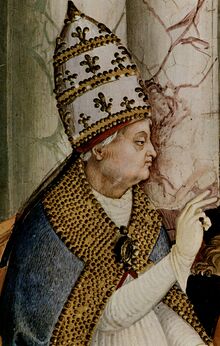مجلس مانتوا (1459)

مجلس مانتوا 1459,[1] or Congress of Mantua, was a religious meeting convoked by Pope Pius II, who had been elected to the Papacy in the previous year and was engaged in planning war against the Ottoman Turks, who had taken Constantinople in 1453. His call went out to the rulers of Europe, in an agonized plea to turn from internecine warfare[2] to face Christendom's common enemy.
. . . . . . . . . . . . . . . . . . . . . . . . . . . . . . . . . . . . . . . . . . . . . . . . . . . . . . . . . . . . . . . . . . . . . . . . . . . . . . . . . . . . . . . . . . . . . . . . . . . . . . . . . . . . . . . . . . . . . . . . . . . . . . . . . . . . . . . . . . . . . . . . . . . . . . . . . . . . . . . . . . . . . . . .
عملية مجلس 1459

Pius entered Mantua on 27 May; his long progress to the place of assembly resembled a triumphal procession. He opened the council on 1 June and waited in Mantua as the guest of Ludovico III Gonzaga until September for the various representatives to assemble. On 26 September he called for a new crusade against the Ottomans. The refugee Cardinal Bessarion and Cardinal Juan de Torquemada were in attendance. The Duke of Burgundy was represented at the Council by the duke of Clèves, who brought in his train the young Burgundian cleric Ferry de Clugny. The humanist Isotta Nogarola wrote and dispatched to Pope Pius an oration favoring a crusade.
النقد والأثر
Not all the leaders of the Church were in favor of a Crusade. The Venetian Cardinal Ludovico Trevisan, patriarch of Aquileia, met Pius in Siena, 16 March, and followed the pope to Mantua, although he opposed the aims of the Council.[3]
By the time the Council was disbanded in January 1460, an ineffectual call for a new crusade against the Infidel had been decided upon, and proclaimed by Pius on 14 January. One of the only European rulers to fully endorse the Crusade was Vlad III, though he was too preoccupied defending his native Wallachia to contribute troops.[4] The paper crusade was to last for three years and was to prove ineffectual. Pius would die in Ancona, making one last effort to launch this campaign by his own example.
Historians of the Tarot like Heinrich Brockhaus[5] have asserted that the so-called Tarocchi di Mantegna were devised and made during the sitting of this council.
أرغم البابا بيوس الثاني سجسمندو في معاهدة مانتوا (1459) أن يرد إمارته إلى الكنيسة، ولما استعاد الطاغية الجريء قبضته عليها، قذفه البابا بقرار الحرمان، واتهمه بالإلحاد، وقتل الأقارب، ومضاجعة المحارم، والزنا، والاغتصاب، والحنث في الإيمان، والغدر، وتدنيس المقدسات(15). وسخر سجسمندو من هذا القرار وقال إنه لم ينقص كثيراً من تمتعه بالطعام والخمر(16)، ولكن صبر الباب العالم وأسلحته ودهائه تغلبت عليه؛ وانتهى الأمر حين خر سجسمندو في عام 1463 راكعاً أمام مندوب بابوي، وأسلم دولته إلى الكنيسة، وغفرت له ذنوبه. ولكن حميته المتأججة أدت به إلى أن يقود جيشاً من البنادقة، انتصر به على الأتراك في عدة وقائع، وعاد إلى ريمنى ومعه جائزة بدت له من أثمن الجوائز، لا تقل قيمة عن عظام أعظم القديسين - وهي رماد جمستوس بليثو Gemistus Pletho الفيلسوف اليوناني الأفلاطوني الذي كان قد اقترح فعلاً استبدال العقدية الأفلاطونية الوثنية بالدين المسيحي. ودفن سجسمندو كنزه الثمين في قبر فخم بجوار هيكله؛ ومات بعد ثلاث سنين من ذلك الوقت (1468)، ومن حقه علينا ألا نغفله في الصورة المركبة التي نرسمها لعصر النهضة.
الذكرى الفنية
The painter Mantegna had been invited to Mantua by Ludovico in 1457; although remaining in Padua, he painted the Agony in the Garden that is in the National Gallery, London, for its Podestà; in Mantegna's picture, the disciples sleep in Gethsemane, while Jerusalem is envisaged as Constantinople, with the rising crescent moon signifying its capture by the Turk.[6] Long after the pope's death, the artist Pinturicchio painted the convocation of the council among the scene's from Pius' life on the walls of the Piccolomini Library في كاتدرائية سيينا.
ملاحظات ومراجع
- ^ There was a Council of Mantua in 1064 and a Council of Mantua in 1537.
- ^ Though the Wars in Lombardy had been ended by the Peace of Lodi (1454), England was convulsed in the Wars of the Roses, and the Thirteen Years' War was pitting the Prussian cities and the local nobility against the Teutonic Knights, whose support would be crucial in any concerted action against the Turk.
- ^ Salvador Miranda, "The Cardinals of the Holy Roman Church": Ludovico Trevisano
- ^ Treptow, Kurt W. (2000). Vlad III Dracula: the life and times of the historical Dracula. The Center for Romanian Studies. ISBN 973-98392-2-3
- ^ Brockhaus, "Ein edles Geduldspiel: "Die Leitung der Welt oder die Himmelsleiter" die sogenannten Taroks Mantegnas. Vom Jahre 1459-60" Miscellanea di Storia dell'arte in onore di Igino Benvenuto Supino, (Florence) 1933,pp 397-416 (On-line text (German)). "Placed edge to edge, they form a symbolic ladder leading from Heaven to earth", wrote Jean Seznec (The Survival of the Pagan Gods, Princeton University Press, 1940:139).
- ^ J. H. Whitfield, "Mantegna and Constantinople" The Burlington Magazine 119 No. 886 (January 1977), p. 41.